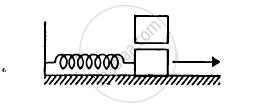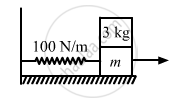Advertisements
Advertisements
Question
A 1 kg block is executing simple harmonic motion of amplitude 0.1 m on a smooth horizontal surface under the restoring force of a spring of spring constant 100 N/m. A block of mass 3 kg is gently placed on it at the instant it passes through the mean position. Assuming that the two blocks move together, find the frequency and the amplitude of the motion.

Solution

It is given that:
Amplitude of simple harmonic motion, x = 0.1 m
Total mass of the system, M = 3 + 1 = 4 kg (when both the blocks move together)
Spring constant, k = 100 N/m
Time period of SHM \[\left( T \right)\] is given by,
\[T = 2\pi\sqrt{\frac{M}{k}}\]
\[\text { On substituting the values of M and k in the bove equation, we have:
\[ T = 2\pi\sqrt{\frac{4}{100}} = \frac{2\pi}{5} s\]
\[\text { Frequency of the motion is given by, }\] \[ \frac{1}{T} = \frac{5}{2\pi} Hz\]
Let v be the velocity of the 1 kg block, at mean position.
\[\text { As kinetic energy is equal to the potential energy, we can write: }\] \[\frac{1}{2}m v^2 = \frac{1}{2}k x^2\]
where x = amplitude = 0.1 m
\[\text { Substituting the value of x in above equation and solving for v, we get: }\]
\[\left( \frac{1}{2} \right) \times \left( 1 \times v^2 \right) = \left( \frac{1}{2} \right) \times 100 \left( 0 . 1 \right)^2 \]
\[ v = 1 {ms}^{- 1} . . . \left( 1 \right)\]
Let V be the velocity of 4 kg block.
Now,
Initial momentum = Final momentum
∴ 1 × v = 4 × V
\[\text { Mean value of kinetic energy is given as, }\]
\[KE \text { at mean position }= \frac{1}{2}M V^2 \]
\[ = \left( \frac{1}{2} \right) \times 4 \times \left( \frac{1}{4} \right)^2 = \frac{1}{2} \times \frac{1}{4} = \frac{1}{8}\]
At the extreme position, the spring-mass system has only potential energy.
\[\therefore \frac{1}{4} = 100 \delta^2 \]
\[ = \delta = \sqrt{\left( \frac{1}{400} \right)}\]
\[ = 0 . 05 \text{ m } = 5 \text{ cm }\]
APPEARS IN
RELATED QUESTIONS
A particle executes simple harmonic motion with an amplitude of 10 cm. At what distance from the mean position are the kinetic and potential energies equal?
The maximum speed and acceleration of a particle executing simple harmonic motion are 10 cm/s and 50 cm/s2. Find the position(s) of the particle when the speed is 8 cm/s.
Consider a particle moving in simple harmonic motion according to the equation x = 2.0 cos (50 πt + tan−1 0.75) where x is in centimetre and t in second. The motion is started at t = 0. (a) When does the particle come to rest for the first time? (b) When does he acceleration have its maximum magnitude for the first time? (c) When does the particle come to rest for the second time ?
A block suspended from a vertical spring is in equilibrium. Show that the extension of the spring equals the length of an equivalent simple pendulum, i.e., a pendulum having frequency same as that of the block.
A body of mass 2 kg suspended through a vertical spring executes simple harmonic motion of period 4 s. If the oscillations are stopped and the body hangs in equilibrium find the potential energy stored in the spring.
The block of mass m1 shown in figure is fastened to the spring and the block of mass m2 is placed against it. (a) Find the compression of the spring in the equilibrium position. (b) The blocks are pushed a further distance (2/k) (m1 + m2)g sin θ against the spring and released. Find the position where the two blocks separate. (c) What is the common speed of blocks at the time of separation?

In following figure k = 100 N/m M = 1 kg and F = 10 N.
- Find the compression of the spring in the equilibrium position.
- A sharp blow by some external agent imparts a speed of 2 m/s to the block towards left. Find the sum of the potential energy of the spring and the kinetic energy of the block at this instant.
- Find the time period of the resulting simple harmonic motion.
- Find the amplitude.
- Write the potential energy of the spring when the block is at the left extreme.
- Write the potential energy of the spring when the block is at the right extreme.
The answer of b, e and f are different. Explain why this does not violate the principle of conservation of energy.

Solve the previous problem if the pulley has a moment of inertia I about its axis and the string does not slip over it.
When a particle executing S.H.M oscillates with a frequency v, then the kinetic energy of the particle?
When the displacement of a particle executing simple harmonic motion is half its amplitude, the ratio of its kinetic energy to potential energy is ______.
A body is executing simple harmonic motion with frequency ‘n’, the frequency of its potential energy is ______.
A body is executing simple harmonic motion with frequency ‘n’, the frequency of its potential energy is ______.
Displacement versus time curve for a particle executing S.H.M. is shown in figure. Identify the points marked at which (i) velocity of the oscillator is zero, (ii) speed of the oscillator is maximum.

Draw a graph to show the variation of P.E., K.E. and total energy of a simple harmonic oscillator with displacement.
Find the displacement of a simple harmonic oscillator at which its P.E. is half of the maximum energy of the oscillator.
A mass of 2 kg is attached to the spring of spring constant 50 Nm–1. The block is pulled to a distance of 5 cm from its equilibrium position at x = 0 on a horizontal frictionless surface from rest at t = 0. Write the expression for its displacement at anytime t.
A body of mass m is attached to one end of a massless spring which is suspended vertically from a fixed point. The mass is held in hand so that the spring is neither stretched nor compressed. Suddenly the support of the hand is removed. The lowest position attained by the mass during oscillation is 4 cm below the point, where it was held in hand.
What is the amplitude of oscillation?
An object of mass 0.5 kg is executing a simple Harmonic motion. Its amplitude is 5 cm and the time period (T) is 0.2 s. What will be the potential energy of the object at an instant t = `T/4` s starting from the mean position? Assume that the initial phase of the oscillation is zero.
A particle undergoing simple harmonic motion has time dependent displacement given by x(t) = A sin`(pit)/90`. The ratio of kinetic to the potential energy of this particle at t = 210s will be ______.
